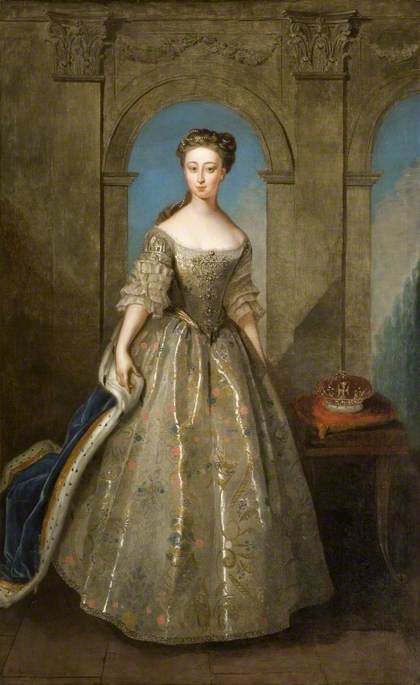by Susan Flantzer © Unofficial Royalty 2019

Credit – Wikipedia
Born at Herrenhausen Palace in the Electorate of Hanover, now in Hanover, Lower Saxony, Germany, on June 10, 1713, exactly two years after the birth of her sister Princess Amelia, Princess Caroline was the fourth of the eight children and the third of the five daughters of the future King George II of Great Britain and his wife Caroline of Ansbach. At the time of her birth, her father was the Hereditary Prince of Brunswick-Lüneburg. Caroline’s paternal grandparents were the future King George I of Great Britain, who was the Elector of Hanover and Duke of Brunswick-Lüneburg at that time, and his divorced, disgraced, and virtually imprisoned first cousin and former wife Sophia Dorothea of Celle. Caroline’s maternal grandparents were Johann Friedrich, Margrave of Brandenburg-Ansbach and his second wife Princess Eleonore Erdmuthe of Saxe-Eisenach. The day after her birth, the infant princess was christened Caroline Elizabeth at Herrenhausen Palace.
Caroline had seven siblings:
- Frederick, Prince of Wales (1707 – 1751), married Princess Augusta of Saxe-Gotha, had issue, including King George III
- Anne, Princess Royal (1709 – 1759), married Willem IV, Prince of Orange, had issue
- Princess Amelia (1711 – 1786), unmarried
- Prince George William (1717 – 1718), died in infancy
- Prince William, Duke of Cumberland (1721 – 1765), unmarried
- Princess Mary (1723 – 1772), married Friedrich II, Landgrave of Hesse-Kassel, had issue
- Princess Louise (1724 -1751), married Frederik V, King of Denmark and Norway, had issue

Frederick, Prince of Wales, playing the cello, Anne, Princess Royal at the harpsichord, Princess Caroline playing the mandora and Princess Amelia reading; Credit – Wikipedia
Caroline’s great-grandmother, Sophia, Electress of Hanover was the heiress presumptive to Queen Anne of Great Britain in accordance with the Act of Settlement 1701, but Sophia died two months before Queen Anne died. Upon Queen Anne’s death on August 1, 1714, Caroline’s grandfather succeeded to the British throne as King George I of Great Britain and her father became the heir apparent to the British throne and was created Prince of Wales the following month. Amelia was then styled Her Royal Highness Princess Caroline of Great Britain. One-year-old Caroline along with her elder sisters Anne and Amelia accompanied their mother to England where they settled in the new home, apartments in St. James’ Palace in London.

The three elder daughters of King George II: Anne, Amelia, and Caroline; Credit – Wikipedia
Caroline’s parents, the Prince and Princess of Wales, had a disagreement over the choice of godparents for the short-lived son George William, born in 1717. The disagreement grew out of proportion, and Caroline’s father George was placed under arrest. The result was that her parents, the Prince and Princess of Wales, were exiled from St. James’ Palace. They moved into Leicester House in Leicester Square, London which became their chief residence for the rest of King George I’s reign. However, their children were kept at St. James’ Palace in the custody of their grandfather. The Prince and Princess of Wales were allowed to see their children only once a week. After a period of two years, the Princess of Wales acted as a mediator for her husband, and in cooperation with Prime Minister Robert Walpole, she finally reconciled King George I and his son.
Princess Caroline was not only her mother’s namesake but her favorite child. She was known in the family for telling the truth and was always consulted when there were disagreements between the royal siblings because she could be counted on telling exactly what happened. On June 11, 1727, Caroline’s grandfather King George I died in Hanover, was buried there, and her father succeeded him as King George II. After the marriage of her eldest sister Anne to Willem IV, Prince of Orange, Caroline became her mother’s main confidant and she remained so for the rest of her mother’s life.

Portrait of Caroline from 1728, probably from the time of her father’s coronation; Credit – Wikipedia
Princess Caroline never married. When her mother died in 1737, Queen Caroline expressly left her three youngest children, all teenagers, in the care of her daughter Caroline. Caroline probably had an affair with John Hervey, 2nd Baron Hervey, a courtier and political writer. Lord Hervey was married and had eight children but apparently, he was bisexual and had affairs with both men and women. It is not known if Lord Hervey had any real affections toward Caroline but apparently she had affections toward him. After Lord Hervey died in 1743 at the age of 46, Caroline became a recluse, rarely leaving St. James’ Palace and seeing only her father, her sister Princess Amelia, her brother Prince William, Duke of Cumberland, and some favorite courtiers. She donated most of her money to charities, especially those associated with prisoners’ welfare, and also saw that Lord Hervey’s children were financially secure.

Lord Hervey; Credit – Wikipedia
Princess Caroline had been a hypochondriac for most of her life and she apparently lost the will to live. As she lay dying, she refused to see any of her family. On December 28, 1757, at the age of 44, Princess Caroline died at St. James’ Palace in London. She was buried in the Hanover vault below the central aisle of Henry VII’s chapel in Westminster Abbey in London. Horace Walpole, a writer and art historian, wrote of Princess Caroline: “Her kindness was constant and united, her immense generosity, her charity were the most extensive; In short, I, not a royalist, can be generous in praise of her.”
This article is the intellectual property of Unofficial Royalty and is NOT TO BE COPIED, EDITED, OR POSTED IN ANY FORM ON ANOTHER WEBSITE under any circumstances. It is permissible to use a link that directs to Unofficial Royalty.
Works Cited
- En.wikipedia.org. (2019). Princess Caroline of Great Britain. [online] Available at: https://en.wikipedia.org/wiki/Princess_Caroline_of_Great_Britain [Accessed 13 Jul. 2019].
- Flantzer, Susan. (2019). Princess Amelia of Great Britain. [online] Unofficial Royalty. Available at: https://www.unofficialroyalty.com/princess-amelia-of-great-britain/ [Accessed 13 Jul. 2019].
- Van der Kiste, J. (2013). King George II and Queen Caroline. New York: The History Press.
- Van Der Kiste, John. The Georgian Princesses. Phoenix Mill: Sutton Publishing, 2000. Print.
- Williamson, David. Brewer’s British Royalty. London: Cassell, 1996. Print. London: Cassell, 1996. Print.
